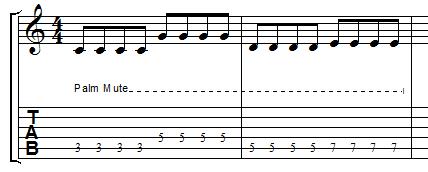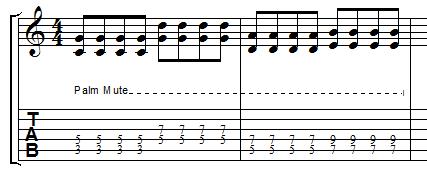Palm Muting
Palm muting is a technique where the picking hand mutes the strings whilst they are being struck. The strings are muted just in front of the bridge with the edge of the palm. Despite the name, palm muting does not produce the same effect as fret hand muting. Fret hand muting involves dampening the strings so that a percussive click is produced instead of a pitch. With palm muting it is possible to hold down frets and produce pitches, although they are more percussive than normal.
Palm muting is mainly used on electrical guitars but has its uses in acoustic music. It is a fundamental aspect of hard rock and heavy metal music. The key to good palm muting is in the positioning of your palm and the amount of pressure you apply to the strings. Below is a set of guidelines to help hone your skills:
- The area on the edge of your palm (opposite the thumb) should lie across the string(s) within two inches of the bridge. The closer you are to the bridge, the lighter the palm mute will be.
- You don't need to press down with your palm. Just the weight of your hand relaxing on the strings should apply enough pressure. Remember, if you press down too hard then you'll completely mute the strings, if you press down too lightly then some strings may ring out.
- If you want to be a good rock guitarist you must be able to apply palm muting to power chords, so don't just practice palm muting single notes.
- To get a good sound it helps to add distortion and turn up the bass on the tone control.
There are loads of ways that you can practice your palm muting. You could learn riffs that use palm muting, play your regular warm ups and exercises palm muted or play scales palm muted. Below is a quick exercise for you to try:
Audio file - figure 1 (120bpm)

Now try the same exercise with power chords. Try using just down strokes to get a more consistent sound.
Audio file - figure 2 (120bpm)
